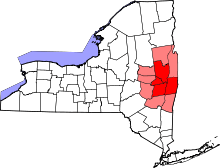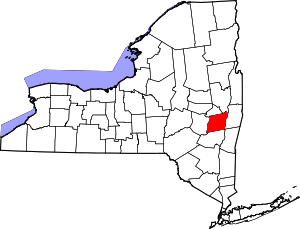Feura Bush, New York
| Feura Bush | |
| hamlet | |
| Formerly: Jerusalem, Moaksville | |
| Name origin: From Dutch vurenbosch meaning fir woods[1] | |
| Country | United States |
|---|---|
| State | New York |
| Region | Capital District |
| County | Albany |
| Municipality | Town of New Scotland |
| Elevation | 266 ft (81 m) |
| Coordinates | 42°35′N 73°53′W / 42.583°N 73.883°WCoordinates: 42°35′N 73°53′W / 42.583°N 73.883°W |
| Timezone | EST (UTC-5) |
| - summer (DST) | EDT (UTC-4) |
| ZIP Code | 12067 |
| Area code | 518 |
|
Location of Feura Bush within the state of New York | |
Feura Bush is a hamlet in the town of New Scotland, Albany County, New York. It is in the southeast corner of the town, along the Bethlehem town-line, eight miles south of Albany. The Feura Bush ZIP Code (12067) includes parts of the town of Bethlehem. It is in the Onesquethaw Volunteer Fire Company fire protection district.
History
Feura Bush was originally called Moaksville for an early family in the vicinity, and later called Jerusalem after the Jerusalem Reformed Church. Harmon Van Der Zee was a major landowner in the area during the mid-18th century.[2] At that time Jerusalem was a part of the town of Bethlehem, in 1832 New Scotland was erected as a separate town.[3] In the 1920s part of the Van Der Zee homestead over the town-line in Bethlehem was taken for the West Shore Railroad's Selkirk rail yard.[2] The yard was originally referred to as being in Feura Bush, being closer to this hamlet than to Selkirk, however it is today in the Selkirk ZIP Code.[4] In 1854 a plank road was established to run through Feura Bush to Houcks Corners, this section is today New York State Route 32; and then from the corners to Bethlehem Center, which today is New York State Route 910A.[5] This road was also made an official post road by the US Congress.[6]
In 1790 the Jerusalem Dutch Reformed Church was established halfway between Union (Unionville) and Jerusalem (Feura Bush). This was the first church in the area immediately south of Albany. In 1825 the church was moved to Jerusalem.[7] The Feura Bush School (Bethlehem School District Number 5) was a one-room school house built in 1885. In 1929 the school was abandoned, and was put to different uses over time until 1987 when the Feura Bush Neighborhood Association converted it to a library.[8] In 1929 a large brick school for kindergarten through eighth grade was built replacing the one-room school house. This building would be in service until around 1950.[9] The West Shore Railroad established a station here around 1870 and it was used to ferry students to Ravena for high school. Around 1940 the station was discontinued.[10] The Jerusalem (later Feura Bush) post office was once located in the Mathias Store until it moved to the hamlet's hotel in 1946 when the store was sold and converted into a residence.[11] A new post office was built in 1989.[2]
Geography
Feura Bush is situated along Main Street (New York Route 32) at the town border with neighboring Bethlehem.
Location
 |
Hamlet of Unionville | Town of Bethlehem Hamlet of Houcks Corners |
 | |
| Hamlet of Clarksville | |
Town of Bethlehem SABIC Innovative Selkirk Plant CSXT Selkirk Rail Yard | ||
| ||||
| | ||||
| Town of Bethlehem Hamlet of South Albany |
Architecture
The hamlet has mostly Victorian and Colonial residences with some modern styles as well. Several are historic buildings from the mid-18th century.[2]
Education
South Bethlehem is a part of the Ravena-Coeymans-Selkirk Central School District (R-C-S) and the children attend A.W. Becker Elementary School for kindergarten through fifth grade; and R-C-S Middle and R-C-S High for sixth through twelfth. The hamlet has a library, situated in the former one room school house.[2]
References
- ↑ John M. Clarke (November 1, 1914). "Tenth Report of the Director of the State Museum and Science Department:The Place Names of Albany County". University of the State of New York Bulletin. University of the State of New York. 173 (578): 49. Retrieved 2010-03-14.
- 1 2 3 4 5 Frances Ingraham (December 27, 1992). "Rural Hamlet: the Private Life of Feura Bush". p. G1. Retrieved 2010-03-09.
- ↑ B.F. Butler and J.C. Spencer (1836). The Revised Statutes of the State of New York, as Altered by the Legislature; Including the Statutory Provisions of a General Nature, Passed From 1828 to 1835 Inclusive. III. State of New York/Packard and Van Benthuysen. p. 47. Retrieved 2010-03-09.
- ↑ "Railway and Industrial Section of the Commercial & Financial Chronicle". The Financial Review. William B. Dana Company. 98 (2540): 5. February 28, 1914. Retrieved 2010-03-09.
- ↑ George Howell and Jonathan Tenney (1886). Bi-Centennial History of Albany: History of the County of Albany from 1609-1886; Volume II. W.W. Munsell and Company. p. 791. Retrieved 2010-03-09.
- ↑ George Minot, ed. (1855). The Statutes at Large and Treaties of the United States of America. From December 1, 1851, to March 3, 1855. X. Little, Brown and Company. p. 368. Retrieved 2010-03-09.
- ↑ George Howell and Jonathan Tenney (1886). Bi-Centennial History of Albany: History of the County of Albany from 1609-1886; Volume II. W.W. Munsell and Company. p. 898. Retrieved 2010-03-09.
- ↑ New Scotland Historical Association (2000). New Scotland Township. Arcadia Publishing. p. 86. ISBN 0-7385-0420-3. Retrieved 2010-03-09.
- ↑ New Scotland Historical Association (2000). New Scotland Township. Arcadia Publishing. p. 88. ISBN 0-7385-0420-3. Retrieved 2010-03-09.
- ↑ New Scotland Historical Association (2000). New Scotland Township. Arcadia Publishing. p. 72. ISBN 0-7385-0420-3. Retrieved 2010-03-09.
- ↑ New Scotland Historical Association (2000). New Scotland Township. Arcadia Publishing. p. 49. ISBN 0-7385-0420-3. Retrieved 2010-03-09.

